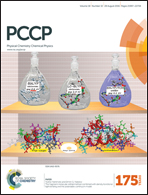Probing the interactions of structurally similar but chemically distinguishable organic solutes with 1-ethyl-3-methylimidazolium alkyl sulfate (alkyl = ethyl, hexyl and octyl) ionic liquids through fluorescence, NMR and fluorescence correlation spectroscopy (FCS) studies†
Abstract
The rotational diffusion of two organic solutes, 4-(azitidine-1-yl)-7-nitrobenzo[1,2,5]oxadi-azole (ANBD) and 7-nitrobenzo[1,2,5]oxadiazole-4-amine (HNBD), has been examined in 1-ethyl-3-methylimidazolium alkyl sulfate (alkyl = ethyl, hexyl and octyl) ionic liquids with the aim of understanding intermolecular interactions among solute and solvent molecules. Solute–solvent interaction has also been investigated by employing fluorescence, NMR and fluorescence correlation spectroscopy (FCS). The ionic liquids (ILs) having a fixed cationic moiety are chosen to monitor the roles of the alkyl chain length as well as the solute–anion (sulfate) interactions in the rotational diffusion of the solutes in the given ILs. In the present study, two chemically distinguishable solutes with structural similarity in their fluorophore unit are employed so that the difference in the rotational behavior of the solutes, if any, can be correlated with the solute–solvent interactions, and not with other factors like the size of the solutes etc. The steady state absorption and emission data indicate that HNBD and ANBD exist in different microenvironments in both ILs. The rotational diffusion data for both the solutes have been analyzed in light of hydrodynamic and quasi hydrodynamic theories. Interestingly, the rotational dynamics of ANBD is observed to be relatively fast and shows slip hydrodynamics, whereas HNBD exhibits hindered rotation with superstick behavior. The hindered rotation of HNBD as compared to that of ANBD in both ILs has been explained by considering the strong hydrogen bonding interactions between the two N–H groups of HNBD and sulfate anions of ILs. The faster rotation of ANBD with the increasing anion chain length has been explained by invoking quasi hydrodynamic theory. The presence of a specific hydrogen bonding interaction between solute (HNBD) and solvent (ILs) molecules has been confirmed by 1H-NMR experiments. FCS measurements have independently demonstrated the relatively strong association of HNBD with the present ILs as compared to that of ANBD.


 Please wait while we load your content...
Please wait while we load your content...